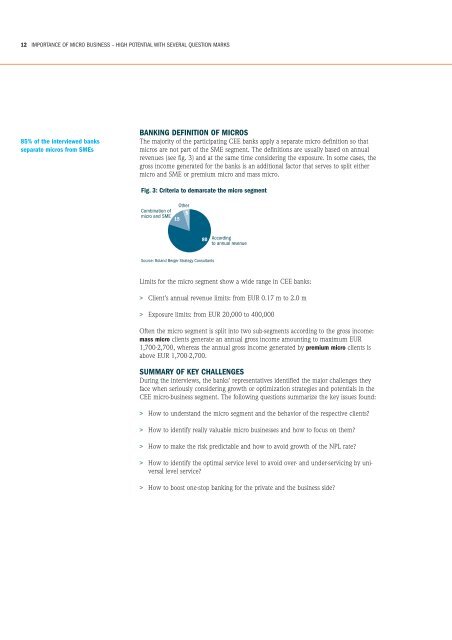Retail Banking in CEE: Exploiting the Potential of ... - Roland Berger
Retail Banking in CEE: Exploiting the Potential of ... - Roland Berger Retail Banking in CEE: Exploiting the Potential of ... - Roland Berger
12 IMPORTANCE OF MICRO BUSINESS – HIGH POTENTIAL WITH SEVERAL QUESTION MARKS 85% of the interviewed banks separate micros from SMEs BANKING DEFINITION OF MICROS The majority of the participating CEE banks apply a separate micro definition so that micros are not part of the SME segment. The definitions are usually based on annual revenues (see fig. 3) and at the same time considering the exposure. In some cases, the gross income generated for the banks is an additional factor that serves to split either micro and SME or premium micro and mass micro. Limits for the micro segment show a wide range in CEE banks: > Client's annual revenue limits: from EUR 0.17 m to 2.0 m > Exposure limits: from EUR 20,000 to 400,000 Often the micro segment is split into two sub-segments according to the gross income: mass micro clients generate an annual gross income amounting to maximum EUR 1,700-2,700, whereas the annual gross income generated by premium micro clients is above EUR 1,700-2,700. SUMMARY OF KEY CHALLENGES During the interviews, the banks' representatives identified the major challenges they face when seriously considering growth or optimization strategies and potentials in the CEE micro-business segment. The following questions summarize the key issues found: > How to understand the micro segment and the behavior of the respective clients > How to identify really valuable micro businesses and how to focus on them > How to make the risk predictable and how to avoid growth of the NPL rate > How to identify the optimal service level to avoid over- and under-servicing by universal level service > How to boost one-stop banking for the private and the business side
IMPORTANCE OF MICRO BUSINESS – HIGH POTENTIAL WITH SEVERAL QUESTION MARKS 13 After the root cause analysis of these questions, they were grouped so that each identified fear or concern could be classified in one of the three categories in the model shown in figure 4. CEE banks' challenges and questions can be grouped into three topics – Strategy, risk management, cross-segment offering In the following sections, you will find detailed analyses and recommendations for these three major topics.
- Page 1: RETAIL BANKING IN CEE EXPLOITING OP
- Page 5: PREFACE 3 PREFACE EFMA AND ROLAND B
- Page 8 and 9: 6 SUMMARY OF KEY FINDINGS SUMMARY O
- Page 11 and 12: 9 PART I IMPORTANCE OF MICRO BUSINE
- Page 13: IMPORTANCE OF MICRO BUSINESS - HIGH
- Page 18 and 19: 16 MICRO STRATEGIES - ELABORATING S
- Page 20 and 21: 18 MICRO STRATEGIES - ELABORATING S
- Page 22 and 23: 20 MICRO STRATEGIES - ELABORATING S
- Page 24 and 25: 22 MICRO STRATEGIES - ELABORATING S
- Page 26 and 27: 24 MICRO STRATEGIES - ELABORATING S
- Page 29 and 30: 27 PART III RISK MANAGEMENT - MANAG
- Page 31: RISK MANAGEMENT - MANAGING RISK COS
- Page 34 and 35: 32 CROSS-SEGMENT OFFERING - UTILIZI
- Page 36 and 37: 34 CROSS-SEGMENT OFFERING - UTILIZI
- Page 38 and 39: 36 CROSS-SEGMENT OFFERING - UTILIZI
- Page 41 and 42: 39 PART V SUMMARY - RECOMMENDATIONS
- Page 43 and 44: SUMMARY - RECOMMENDATIONS FOR "MICR
- Page 45: METHODOLOGY AND SCOPE OF THE STUDY
- Page 49: 47 Many thanks to the following per
12<br />
IMPORTANCE OF MICRO BUSINESS – HIGH POTENTIAL WITH SEVERAL QUESTION MARKS<br />
85% <strong>of</strong> <strong>the</strong> <strong>in</strong>terviewed banks<br />
separate micros from SMEs<br />
BANKING DEFINITION OF MICROS<br />
The majority <strong>of</strong> <strong>the</strong> participat<strong>in</strong>g <strong>CEE</strong> banks apply a separate micro def<strong>in</strong>ition so that<br />
micros are not part <strong>of</strong> <strong>the</strong> SME segment. The def<strong>in</strong>itions are usually based on annual<br />
revenues (see fig. 3) and at <strong>the</strong> same time consider<strong>in</strong>g <strong>the</strong> exposure. In some cases, <strong>the</strong><br />
gross <strong>in</strong>come generated for <strong>the</strong> banks is an additional factor that serves to split ei<strong>the</strong>r<br />
micro and SME or premium micro and mass micro.<br />
Limits for <strong>the</strong> micro segment show a wide range <strong>in</strong> <strong>CEE</strong> banks:<br />
> Client's annual revenue limits: from EUR 0.17 m to 2.0 m<br />
> Exposure limits: from EUR 20,000 to 400,000<br />
Often <strong>the</strong> micro segment is split <strong>in</strong>to two sub-segments accord<strong>in</strong>g to <strong>the</strong> gross <strong>in</strong>come:<br />
mass micro clients generate an annual gross <strong>in</strong>come amount<strong>in</strong>g to maximum EUR<br />
1,700-2,700, whereas <strong>the</strong> annual gross <strong>in</strong>come generated by premium micro clients is<br />
above EUR 1,700-2,700.<br />
SUMMARY OF KEY CHALLENGES<br />
Dur<strong>in</strong>g <strong>the</strong> <strong>in</strong>terviews, <strong>the</strong> banks' representatives identified <strong>the</strong> major challenges <strong>the</strong>y<br />
face when seriously consider<strong>in</strong>g growth or optimization strategies and potentials <strong>in</strong> <strong>the</strong><br />
<strong>CEE</strong> micro-bus<strong>in</strong>ess segment. The follow<strong>in</strong>g questions summarize <strong>the</strong> key issues found:<br />
> How to understand <strong>the</strong> micro segment and <strong>the</strong> behavior <strong>of</strong> <strong>the</strong> respective clients<br />
> How to identify really valuable micro bus<strong>in</strong>esses and how to focus on <strong>the</strong>m<br />
> How to make <strong>the</strong> risk predictable and how to avoid growth <strong>of</strong> <strong>the</strong> NPL rate<br />
> How to identify <strong>the</strong> optimal service level to avoid over- and under-servic<strong>in</strong>g by universal<br />
level service<br />
> How to boost one-stop bank<strong>in</strong>g for <strong>the</strong> private and <strong>the</strong> bus<strong>in</strong>ess side



